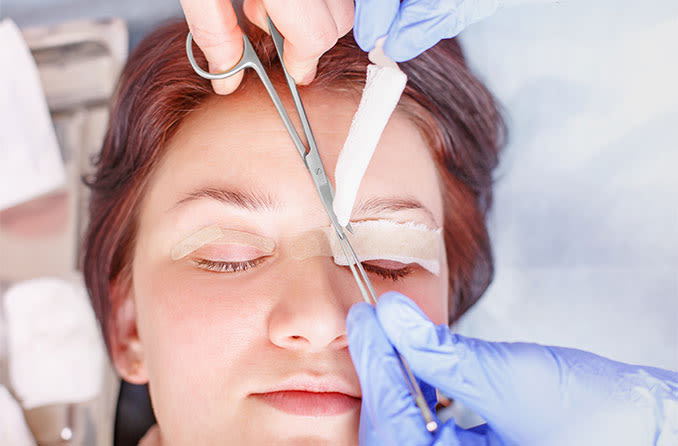How is ptosis treated?

Generally, ptosis (drooping of the upper eyelid) is treated with eyelid surgery.
In ptosis surgery — also called blepharoplasty (‘BLEF-uh-row-plas-tee”) — the muscles responsible for lifting the upper eyelid are repositioned to restore the lid to a more natural (elevated) position. Removal of excess skin and fat from the upper eyelid and surrounding tissue may also be involved.
Here are some key facts about surgical and non-surgical ptosis treatments:
Surgery
Eyelid surgery is often the best treatment for ptosis, for patients of all ages. As mentioned above, during ptosis surgery, the surgeon repositions or tightens muscles in the upper eyelid to raise the lid, thus improving appearance and vision.
For more severe cases or when levator muscles are especially weak, a special procedure might be performed to enable the forehead muscles to help elevate the eyelid.
Medical injections
Medical injections such as Botox can sometimes be used as treatment for those with very mild cases of ptosis. However, Botox and other injections show only temporary improvements. Ptosis as a medical condition, meaning it is affecting quality of vision, will likely require surgery eventually.
Keep in mind that Botox injections to treat droopy eyelids will only slightly improve cosmetic appearance. It’s also extremely important to only have Botox injections for ptosis done by an experienced eye care professional, as Botox injections around the eye can actually cause ptosis if not done correctly.
SEE RELATED: Drooping eyelids after Botox
Eyeglasses for ptosis
Eyeglasses and contact lenses may help with the clarity of vision for ptosis patients, but they are not necessarily primary treatment methods for the condition itself.
A ptosis crutch, which is a small bar placed on the inner rim of the eyeglasses, is sometimes recommended to help support a drooping upper eyelid. The bar is placed where the orbital fold would be located without ptosis and creates a fold above the eye to raise the eyelid position.
Natural and home remedies
Beware of natural treatments and home remedies for ptosis, as they are not medically proven to help.
Some natural treatments, such as placing chamomile tea bags and cucumber slices over eyes, can help to reduce some puffiness, which can improve the look of ptosis to a degree. However, it is important to understand that these treatments are temporary and only affect the cosmetic appearance of sagging eyelids. They are not an effective fix for treating ptosis.
Eye exercises
Like natural and home remedies, eye exercises for ptosis should be approached with caution and should not be relied upon as a primary treatment for the condition.
Some sources have stated that droopy eyelid exercises can stimulate eye muscles and improve the appearance and feeling of droopy eyelids. However, performing these exercises incorrectly can cause more damage than good, and they are not medically proven to treat ptosis.
What is the best treatment for ptosis?
Before moving forward with a specific droopy eyelid treatment or ptosis repair, it’s important to identify exactly what type of ptosis needs to be corrected and what caused the ptosis in the first place.
Congenital ptosis should be treated as soon as possible so vision can develop properly. An eye doctor will recommend the best treatment for babies born with the condition.
If ptosis developed due to an underlying condition such as an illness, injury or secondary condition, that underlying condition should receive primary treatment.
Botox and other injectable muscle relaxers may be recommended as a temporary fix for aging eyes or age-related ptosis. Surgical options may also be available, depending on the severity of each case.
SEE RELATED: UPNEEQ eye drops for ptosis
What happens if ptosis isn’t treated?
If ptosis is not corrected early on, it can cause vision problems, like amblyopia (lazy eye). Children born with moderate to severe ptosis often require surgery to ensure that vision develops properly.
And because ptosis also can develop later in life, it is crucial to have annual eye exams. If you are showing signs or symptoms of ptosis, it's important to see an eye doctor to determine if ptosis treatment is needed.
Page published on Tuesday, September 22, 2020






